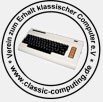Gestern ist ja leider mein Alphatronic P3 kaputt gegangen (wie hier erwähnt: UCSD Pascal für die P3).
Ich habe mich also auf die Fehlersuche begeben und den Fehler inzwischen zumindest eingegrenzt:
Wenn ich den Rechner ohne Speicherkarte und Floppy Controller starte, so erscheint meist korrekt der MOS Startbildschirm:
Reset4001 4000
CAAP-3603 1B76 4000 40FF
Beim Einsetzen von zwei 16 KB SRAM Karten aus der P2 (mit Basisadresse 8000 und C000) kommt ebenfalls meistens der obige Startbildschirm (manchmal bleibt der Rechner allerdings mit der Meldung Reset hängen).
Nach der MOS Meldung können die üblichen MOS Befehle eingegeben werden. Beschreiben des Bildschirmspeichers ab $3000 bzw. der SRAM Karten ab $8000 und $C000 funktioniert (Fxxxx,yyyy,zz und Dxxxx,yyyy liefern die gewünschten Ergebnisse).
Allerdings kann ich den Speicher direkt auf der CPU Karte nicht beschreiben. Auch wenn ich die originale 64 KB DRAM Karte, ein drittes SRAM Modul (ab $4000) oder den Floppy Controller einsetze, so bleibt der Rechner mit der Meldung Reset hängen bzw. versucht den Boot-Prozess durchzuführen und hängt dann mit blinkender Reset Meldung).
Offenbar hat die Bus-Adressierung auf der CPU Karte (möglicherweise auch die Logik zur Umschaltung zwischen 48K und 64K Modus) etwas abbekommen. Damit habe ich zumindest eine erste Spur, weitere Tests werden nun wohl etwas mühsamer. Entweder ich mache mich mit dem Oszilloskop auf die Suche, oder ich versuche eine Fehlereingrenzung mit einfachen 8085 Maschinensprachprogrammen.

